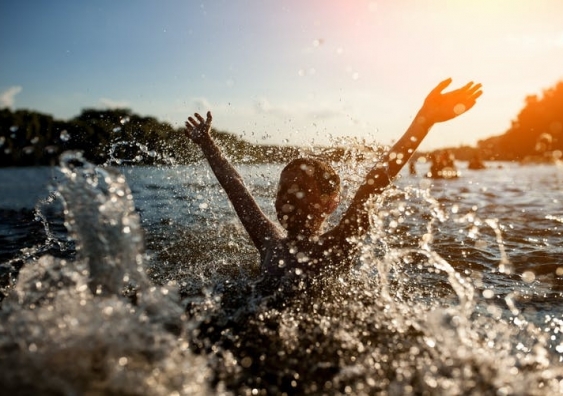The eight deadly days of Christmas: how to stay safe from drowning in Australia this summer
Australians are entering our most dangerous time of year for fatal drownings. So what can you do to keep yourself and loved ones safer this summer?
Australians are entering our most dangerous time of year for fatal drownings. So what can you do to keep yourself and loved ones safer this summer?

Christmas is coming – meaning Australians are about to enter our most dangerous time of year for fatal drownings.
The eight days from Christmas Day to New Year’s Day are the deadliest period for drowning, with 201 lives lost over the past 15 years, according to my new analysis.
Using coronial data from the Royal Life Saving Society – Australia, my analysis shows a further 28 people drowned on Australia Day during the same 15 year period. My findings back up previous research, which found people are twice as likely to drown in Australia on a public holiday than any other day.
But the danger isn’t limited to major holidays. January 10 inexplicably emerged from my analysis as a key date, with 32 people drowning over the past 15 years – more than on any other single day of the year.
The sadly predictable spikes in preventable drownings mean many river rescue divers and surf life savers have come to dread summer.
The Murray River is Australia’s leading river drowning black spot.
For more than 40 years, Peter Wright OAM, a volunteer rescue diver with the Corowa Rescue Squad, has performed the harrowing task of retrieving bodies – including children – from the river:
I have this feeling of dread as summer approaches. I find myself avoiding going near the river, as seeing people behaving badly or irresponsibly really gets to me […] I know it’s not if, but when we will be called to search the river for the next drowning victim […] The look of abject grief and disbelief on the faces of relatives and the noise of wailing families haunts me to this day.
‘Don’t panic, keep your head up’: Volunteer divers Stuart Dye and Peter Wright’s stories of avoidable drownings in the Murray River. Photo: Royal Life Saving Society – Australia.
Data from Surf Life Saving Australia paint a similar story.
The number of people who get into trouble at the beach spikes on public holidays. With an average of 20 rescues per day across the year in 2020/21, the period from Christmas Day to New Year’s Day sees this figure increase almost six-fold, with an average of 116 rescues per day.
According to Chris Jacobson, National Surf Life Saving Australia’s chair of lifesaving and a volunteer surf lifesaver of 20 years:
Surf lifesavers are constantly on the go attending to numerous rescues during this period, in particular on Australia Day. We see people not swimming between the flags, ignoring lifesavers, drinking and overestimating their abilities, which therefore requires our members to go to their aid.
Do you know how to spot a rip at the beach? Surf Life Saving Australia.
So why are Australians more likely to drown in summer, particularly on public holidays? And how can you be safer this summer?
Australia Day aftermath: a beer-filled raft beside the Murray River at Albury. Photo: Amy Peden, Author provided
Alcohol
Alcohol is a leading risk factor for drowning. It impairs reaction time, impacts the effectiveness of cardiopulmonary resuscitation (CPR) and can result in risk-taking behaviour.
Our breathalysing research at rivers – which are the leading location for drowning in Australia – found the average blood alcohol concentration (BAC) for adult river users was significantly higher on the Australia Day public holiday, with an average BAC of 0.175 per cent. That’s more than three times the legal limit for driving a car.
Several river users also registered BACs in excess of 0.350 per cent, seven times the legal limit.
Drinking beside inland waterways is a key reason why so many people drown in them. Photo: Royal Life Saving Society.
Participation and exposure
More people in and around the water means more people at risk of drowning.
Our research shows higher numbers of people visit aquatic locations on holiday periods during summer, including the Australia Day public holiday. This is also sadly evidenced in the rescue and fatal drowning data.
Warmer temperatures
This deadly period for drowning often coincides with hot temperatures. Warmer weather drives people to seek out water to cool off, but are also linked to higher blood alcohol concentrations.
Higher air temperature also lead people to spend longer in the water.
School holidays
School attendance has been shown to be protective against drowning, with school-aged children 5-17 years old 2.4 times more likely to drown during school holidays.
The Christmas school holidays also coincide with this high-risk period and a number of public holidays.
Visitors who don’t know local conditions
In a normal, non-COVID summer, many Australians travel on their summer break, including to unfamiliar aquatic locations.
Our research shows visitors have increased drowning risk on public holidays compared to other days: 2.5 times the risk for people travelling within their own state, and 2.3 times the risk for those visiting other states or territories.
Those simple steps can save lives – and avoid so much needless pain, as volunteer rescue diver Peter Wright says:
A drowning affects so many people. Not just the family but all those involved in the recovery, the police, ambulance and divers. It is often more difficult to cope with the pain-filled reactions of a family when you recover their loved one, than the task of diving in totally black, fast-running, snag-filled water, feeling for that lost individual. I just wish that people took water safety more seriously.
For more water safety information, visit Royal Life Saving Society – Australia and Surf Life Saving Australia.

Amy Peden, Lecturer - Injury Prevention, UNSW
This article is republished from The Conversation under a Creative Commons license. Read the original article.